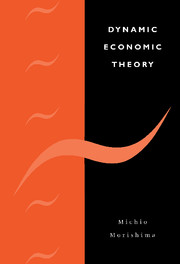Book contents
- Frontmatter
- Contents
- Preface
- 1 The method of dynamic analysis
- 2 Households' and firms' economic behaviour
- 3 Stability conditions for a temporary equilibrium: the linear case
- 4 Stability conditions for a temporary equilibrium: the non-linear case
- 5 Comparative dynamics
- Appendices
- Mathematical notes
- ADDENDUM
- Introduction
- Article I Walras' own theory of tatonnement [partly written in 1958]
- Article II Tatonnement in quantities: truncation, equilibration, growth [1956]
- Article III A contribution to the non-linear theory of the trade cycle [1958]
- Article IV Stability, oscillations and chaos
- Article V A generalization of the gross substitute system [1970]
- Article VI The laws of the working of the quasi-Frobenian system [1954, yet unpublished]
- Article VII The Cournot–Walras arbitrage, resource consuming exchange, and competitive equilibrium (with M. Majumdar) [1978]
- Article VIII The dilemma of durable goods
- References
- Index
Article III - A contribution to the non-linear theory of the trade cycle [1958]
Published online by Cambridge University Press: 08 February 2010
- Frontmatter
- Contents
- Preface
- 1 The method of dynamic analysis
- 2 Households' and firms' economic behaviour
- 3 Stability conditions for a temporary equilibrium: the linear case
- 4 Stability conditions for a temporary equilibrium: the non-linear case
- 5 Comparative dynamics
- Appendices
- Mathematical notes
- ADDENDUM
- Introduction
- Article I Walras' own theory of tatonnement [partly written in 1958]
- Article II Tatonnement in quantities: truncation, equilibration, growth [1956]
- Article III A contribution to the non-linear theory of the trade cycle [1958]
- Article IV Stability, oscillations and chaos
- Article V A generalization of the gross substitute system [1970]
- Article VI The laws of the working of the quasi-Frobenian system [1954, yet unpublished]
- Article VII The Cournot–Walras arbitrage, resource consuming exchange, and competitive equilibrium (with M. Majumdar) [1978]
- Article VIII The dilemma of durable goods
- References
- Index
Summary
Introduction
We have already two non-linear models of trade cycles which seek in non-linearities an explanation of the maintenance of trade cycles: that is, the Kaldor–Yasui and the Hicks–Goodwin models. The most controversial of the assumptions underlying these two models are those concerning the determinants of investment decisions. The rate of investment is assumed in the Kaldor–Yasui theory to depend on the level of income (the profit principle) and in the Hicks–Goodwin theory on the rate of change in income (the acceleration principle). But Dr Kalecki's analysis of the correlation between the rate of investment, the level of income, and the rate of change in income shows that a better approximation is obtained if investment is considered as a function, both of the level and of the rate of change in income, than of either of them only. On this basis neither of the Kaldor–Yasui and the Hicks–Goodwin models can claim to be the best representation of actual cycles. In this article we shall be concerned with a more realistic model; namely, a synthesis of our predecessors.
Assumption
To begin with, we state the Kaldor and the Hicks–Goodwin investment functions in precise terms.
- Type
- Chapter
- Information
- Dynamic Economic Theory , pp. 222 - 233Publisher: Cambridge University PressPrint publication year: 1996



